Overview
The article highlights the importance of understanding A1C target levels for effective diabetes management. It's essential to recognize that regular monitoring and personalized care plans can make a significant difference in your health journey. Maintaining A1C levels below 7% can greatly reduce the risk of diabetes-related complications. Research and expert opinions emphasize the collaborative role of healthcare providers in helping you achieve these vital targets.
You're not alone in this journey. It's understandable to feel overwhelmed, but knowing your A1C levels can empower you to take control of your health. By working closely with your healthcare team, you can create a plan tailored to your needs, ensuring that you receive the support necessary for success.
Remember, every small step counts. Regular check-ins with your healthcare provider can guide you in maintaining your A1C levels and improving your overall well-being. We are here to support you every step of the way, providing the resources and encouragement you need to thrive.
Introduction
In the intricate landscape of diabetes management, the A1C test stands out as a pivotal tool. It offers valuable insights into your average blood sugar levels over the past two to three months. This essential metric not only aids in diagnosing diabetes but also plays a crucial role in evaluating how well your treatment plan is working. With the global diabetes epidemic on the rise, understanding and monitoring A1C levels has never been more critical.
It's understandable to feel overwhelmed as you navigate the complexities of this condition. The importance of personalized A1C targets and collaborative care becomes increasingly evident. By exploring the multifaceted relationship between A1C levels and overall health outcomes, you can empower yourself to take charge of your diabetes management journey. Remember, you're not alone in this journey; we are here to support you every step of the way.
What is A1C and Why is it Important in Diabetes Management?
The A1C test, or hemoglobin A1C, is a vital diagnostic tool that measures the average blood sugar levels over the past two to three months. Expressed as a percentage, it reflects the proportion of hemoglobin molecules that have become glycated, indicating prolonged exposure to elevated glucose levels. This assessment is crucial not only for identifying the condition but also for evaluating how well an individual is managing their A1C target levels.
At TD Solutions, we deeply understand the significance of regular A1C monitoring in customizing treatment plans and preventing complications related to blood sugar disorders. In fact, research indicates that roughly 50% of individuals with the condition consistently check their A1C target levels, highlighting its importance in ongoing management. As the worldwide condition crisis continues to intensify, forecasts suggest that the number of individuals affected in Europe alone may increase from 52 million to 69 million by 2035. The A1C test is anticipated to remain a crucial diagnostic and prognostic instrument.
Furthermore, Germany had over 7.2 million instances of this condition as of 2014, underscoring the widespread nature of it and the critical need for effective monitoring.
Expert opinions emphasize the importance of the A1C test in determining A1C target levels for managing blood sugar conditions. According to Eyth E., "Hemoglobin A1C is a valuable tool in managing blood sugar disorders and other glycemic control issues, but it functions best in an interprofessional healthcare team environment to be effective." This highlights the cooperative element of health condition care, where healthcare professionals work together to enhance individual results.
In 2025, the focus on A1C target levels is more pronounced than ever, as healthcare providers acknowledge their role in improving outcomes for individuals. Recent studies have also explored alternative methods for measuring glycemic control, such as estimated average glucose and glucose time in range, which utilize continuous glucose monitoring data. While these options may provide a more detailed perspective on blood sugar levels, the A1C test continues to be a fundamental component of overseeing the condition, as mentioned in the case study titled 'Emerging Alternatives to A1C.'
At T2DSolutions, we are here to empower newly diagnosed individuals by offering resources and assistance for effective condition oversight. Real-world examples demonstrate the impact of A1C monitoring on achieving A1C target levels while managing blood sugar conditions. Patients who consistently track their A1C target levels often experience better control over their blood sugar, leading to fewer complications and improved overall health.
This reinforces the notion that effective management of the condition is a collaborative effort, where regular A1C testing plays a pivotal role in empowering patients to make informed decisions about their care.
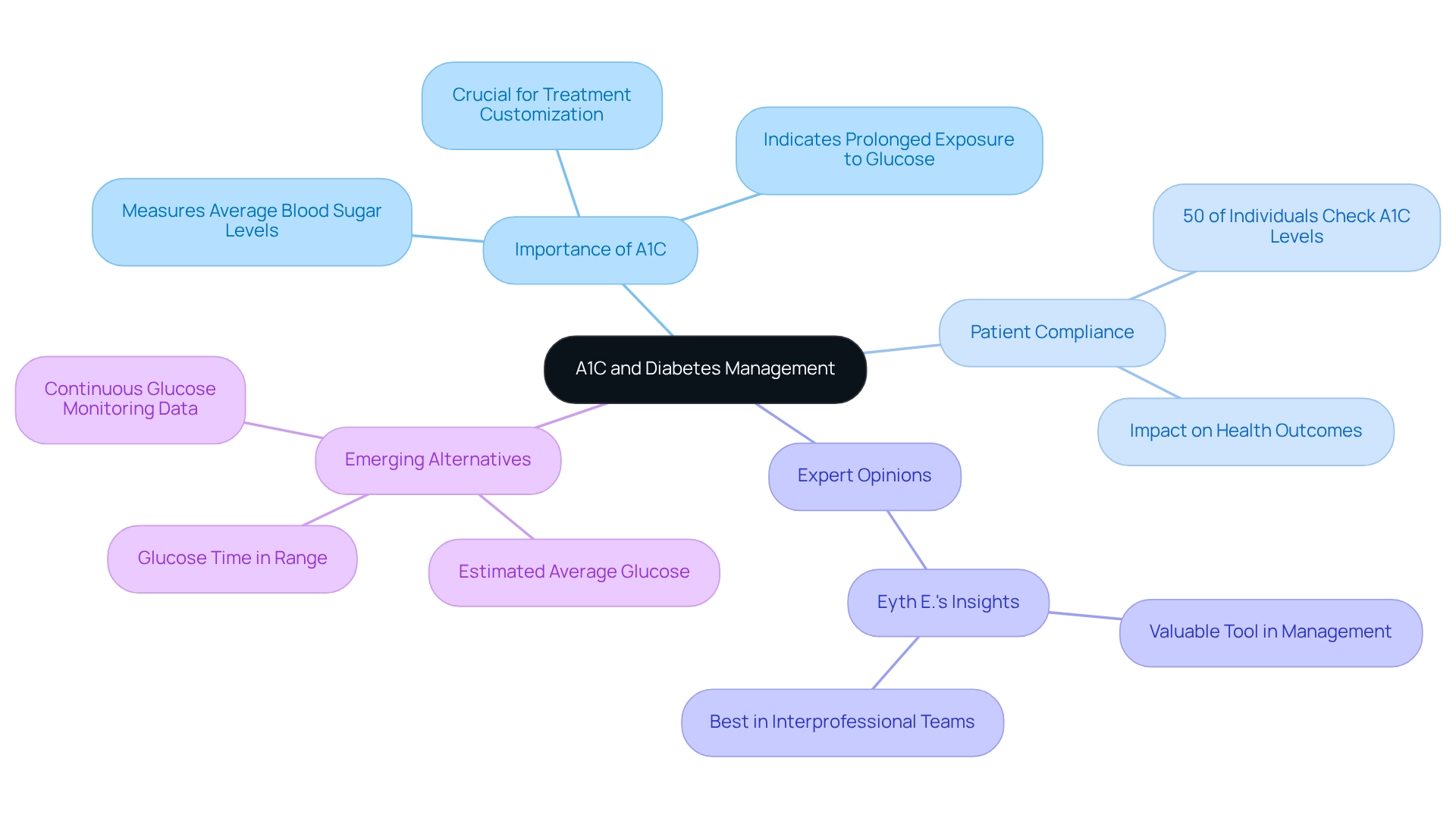
Understanding Normal and Target A1C Levels
Normal A1C levels are generally considered to be below 5.7%. An A1C level between 5.7% and 6.4% suggests prediabetes, while a level of 6.5% or greater confirms a diagnosis of the condition. For most adults managing blood sugar issues, the American Diabetes Association recommends A1C target levels of less than 7%.
However, it's essential to recognize that individual targets can vary significantly based on factors such as age, overall health, and specific medical conditions. Understanding these standards is crucial for patients as they evaluate their health control and make informed wellness choices. For instance, a person maintaining consistent blood sugar levels around 154 mg/dL may achieve an A1C of approximately 7%. This correlation underscores the importance of regular monitoring and personalized care plans.
Recent statistics reveal that 39.5% of adults with the condition have a non-HDL cholesterol level of 130 mg/dL or higher, indicating an increased risk for cardiovascular disease. This highlights the necessity for thorough oversight strategies that tackle not only blood sugar levels but also overall health metrics. In fact, this condition was the eighth leading cause of death in the United States in 2021, underscoring the seriousness of effective management.
As we look ahead to 2025, the current recommendations for A1C target levels continue to emphasize the importance of individualized targets. Experts suggest that while a general goal of less than 7% is appropriate for many, older adults or those with multiple health issues may benefit from slightly higher targets to avoid potential complications from aggressive treatment.
Case studies have indicated that A1C results are classified into normal, prediabetes, and elevated ranges, with the A1C test serving as an essential tool for diagnosis. However, it's important to note that this test is not suitable for diagnosing type 1 diabetes, gestational diabetes, or cystic fibrosis-related conditions, and may yield inaccurate results under certain circumstances. Understanding these restrictions is essential for precise control of blood sugar.
Ultimately, comprehending A1C target levels is a crucial element of successful care for blood sugar levels, enabling individuals to take control of their health and collaborate with healthcare professionals to reach their A1C target levels. As the Cleveland Clinic mentions, 'Together, you can create a plan to move nearer to your objectives and A1C target levels.' At Td Solutions, we are dedicated to offering resources and support for individuals recently diagnosed to assist in navigating their diabetes management journey.
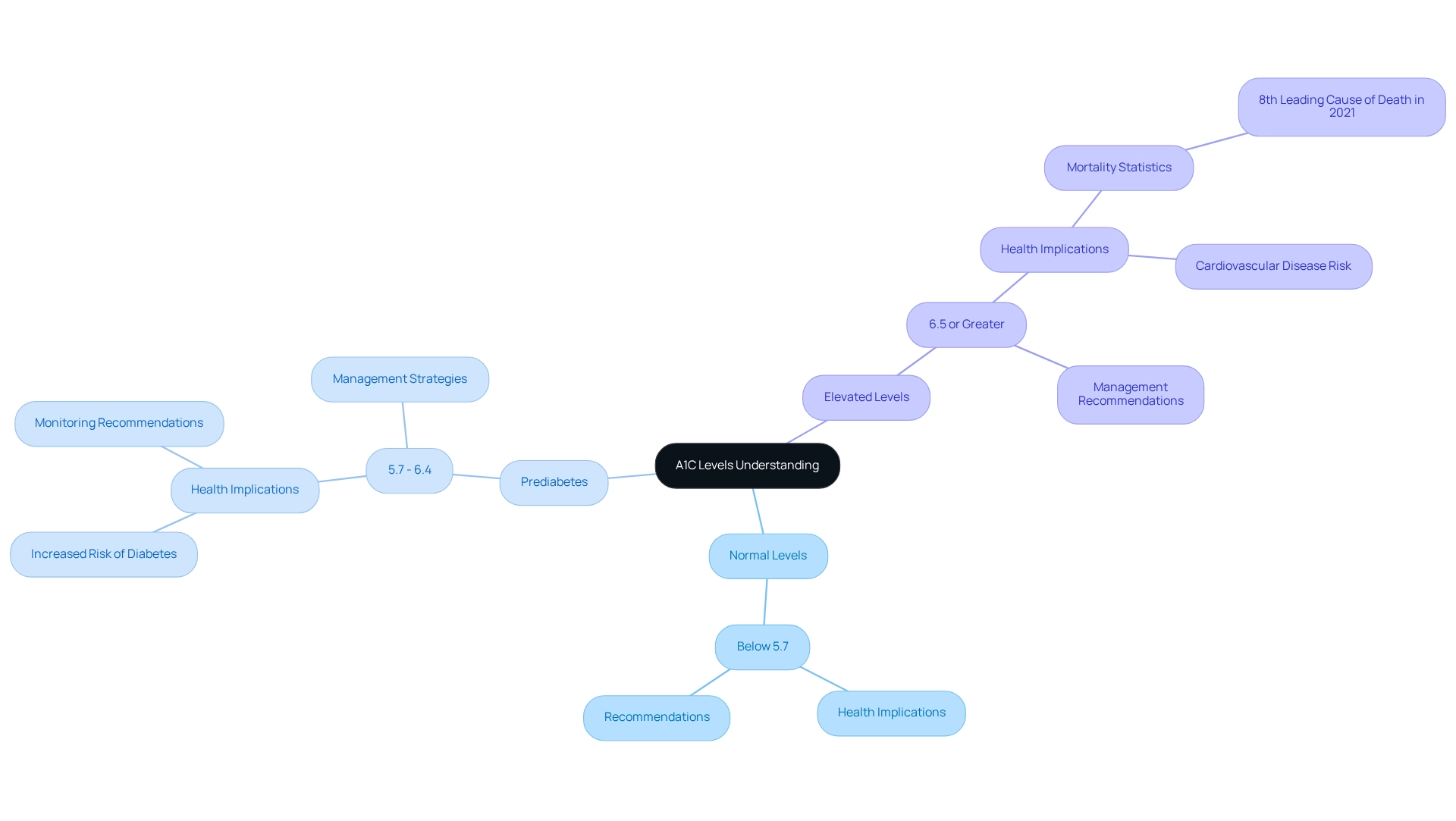
Factors Affecting A1C Test Accuracy
Understanding the accuracy of A1C tests is essential, especially for those navigating blood sugar management. Several critical factors can influence these tests, and it's important to be aware of them. Hemoglobin variants, such as those found in sickle cell disease, can significantly distort results, leading to misinterpretations of your glycemic control. If you've recently had a blood transfusion, this can also be a challenge, as it may alter hemoglobin composition and affect your A1C readings.
Additionally, conditions like anemia can complicate test accuracy, potentially resulting in lower hemoglobin levels that impact your A1C percentage. It's understandable to feel overwhelmed by these complexities, but knowing them can empower you to take control of your health.
Laboratory errors, including improper sample handling or testing procedures, can contribute to inaccurate results as well. It's crucial to inform your healthcare provider of any current medical conditions or medications that might affect your A1C target levels. This transparency not only helps in interpreting results accurately but also allows for tailored management strategies that suit your unique situation.
Recent studies highlight that hemoglobin variants among individuals with blood sugar issues are significant, with some groups displaying higher rates. For instance, many individuals may unknowingly have hemoglobin variants affecting their A1C results, which can lead to potential mismanagement of their condition. Real-world instances emphasize these difficulties; individuals with undiagnosed hemoglobinopathies often face challenges in achieving optimal blood sugar regulation due to misleading A1C readings.
Experts stress the importance of understanding these factors. As noted by hematologists, there is a growing recognition within the medical community to move beyond relying solely on A1C as the standard measure for assessing treatment response. Roopa Naik states, "There is a movement within the medical community to shift away from using HbA1c as an exclusive standard of care test to measure individual response to treatment."
This transition aims to integrate a more refined strategy for managing blood sugar conditions, considering various elements that can affect A1C test precision and your target levels. A recent study revealed a nearly double average insulin total daily dose (TDD) in the discordant-low phenotype compared to the discordant-high phenotype (32 vs. 17 units, p < 0.001), emphasizing the intricacies of care and A1C interpretation. It's important to acknowledge that limitations exist, such as the lack of dietary pattern information and the mental and emotional state of participants, which are recognized as influential factors affecting HbA1c levels.
You're not alone in this journey, and understanding these complexities can help you advocate for your health. Together, we can navigate these challenges and find the support you need.
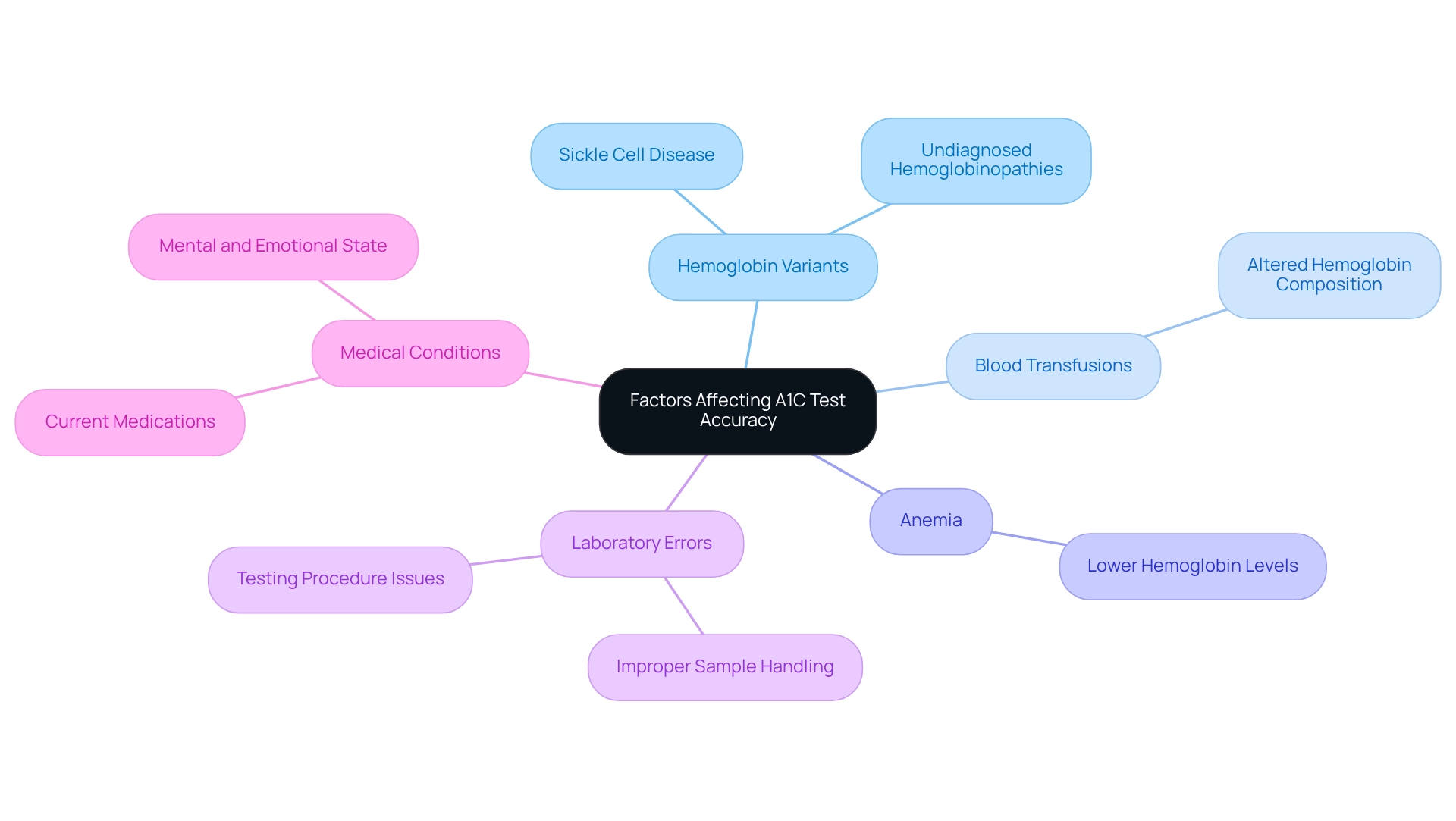
The Impact of A1C Levels on Health Outcomes
Elevated A1C levels are closely linked to a heightened risk of diabetes-related complications, including:
- Cardiovascular disease
- Neuropathy
- Retinopathy
- Kidney disease
Research shows that maintaining A1C levels below 7% can lead to a significant reduction in these risks. For instance, individuals who achieve this goal often experience a notable decrease in complications, underscoring the critical importance of effective A1C control in glucose regulation.
As Priya M John, MPH, from the Section of General Internal Medicine, emphasizes, "Effective control of A1C levels is essential for reducing the risk of complications related to blood sugar issues."
At T2DSolutions, we understand how important A1C management is, and we strive to provide newly diagnosed individuals with the resources and support they need to achieve their health objectives. Regular monitoring of A1C levels is crucial for maintaining long-term health and enhancing the quality of life for those managing this condition. A comprehensive analysis of postoperative complications revealed that patients with higher A1C and pre-induction glucose levels experienced longer ICU stays and poorer outcomes. This highlights the direct correlation between poor glucose control and adverse health events.
The follow-up period for this study spanned from January 1, 2004, to December 31, 2007, providing a robust timeframe for assessing these outcomes.
Additionally, statistics indicate that around 70.8% of U.S. adults diagnosed with the condition have systolic blood pressure measurements of 140 mmHg or above. This fact emphasizes the relationship between A1C levels and overall health care. Evaluations of anthropometric data, lifestyle habits, and diet via self-administered questionnaires further support a comprehensive approach to health control. Expert opinions consistently stress that maintaining A1C levels below 7% is vital for minimizing the risk of complications and improving long-term health outcomes for individuals facing blood sugar challenges.
By focusing on A1C control, individuals can significantly reduce the risk of severe health problems associated with elevated A1C levels. T2DSolutions is dedicated to being a thorough resource for education and support related to blood sugar management, assisting individuals in navigating their journey toward improved health.
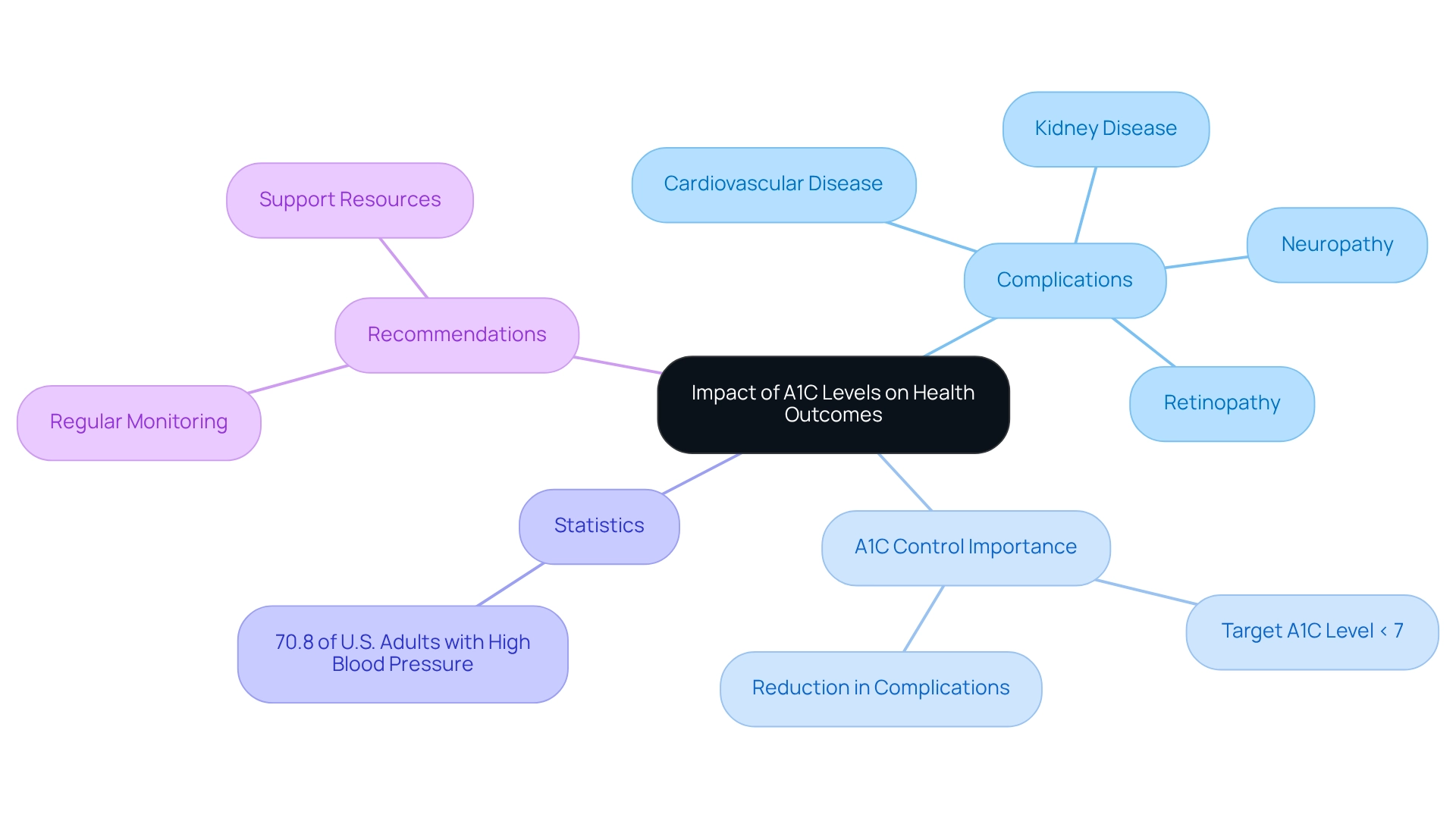
Personalizing A1C Targets for Optimal Diabetes Management
Customizing A1C target levels is essential for effectively managing blood sugar levels. This process requires careful consideration of various factors, including age, duration of the condition, existing complications, and individual preferences. For instance, older adults or those with multiple health conditions may find less stringent A1C targets beneficial, which could include an A1C level between 7.5% and 8%. If HbA1c levels rise to 58 mmol/mol (7.5%) or higher, it's important to provide support aimed at achieving an HbA1c level of 53 mmol/mol (7.0%).
This approach acknowledges that the potential risks of intensive glycemic management can outweigh the benefits for specific groups, particularly older individuals. In these cases, the focus should shift toward alleviating symptoms rather than strictly adhering to A1C targets.
At T2DSolutions, we understand the importance of collaborating with healthcare professionals to establish realistic and attainable A1C target levels. This partnership can significantly enhance motivation and compliance with care plans. It allows for tailoring targets based on individual health status and life expectancy. Recent guidelines emphasize the importance of personalized A1C plans, which can lead to improved outcomes and a better quality of life for individuals.
As Matthew C. Riddle from the Division of Endocrinology, Diabetes & Clinical Nutrition at Oregon Health & Science University notes, "The ADA’s current statement provides appropriately balanced guidance."
Statistics show that A1C targets tailored to individuals can lead to higher adherence rates across different age groups. This reinforces the necessity for a customized approach. Providers should also be mindful that HbA1c variability poses a risk for microvascular and macrovascular outcomes, underlining the importance of monitoring A1C levels. Specialists in this field advocate for this approach, emphasizing that it fosters a more supportive environment for individuals navigating their health journey.
The case study titled 'Individualizing HbA Targets for Older Adults' illustrates the need for tailored A1C target levels, especially for older adults with various comorbid conditions. This strengthens the argument for personalized strategies in healthcare. By prioritizing personal needs and circumstances, healthcare professionals can help individuals reach their A1C target levels more effectively, leading to improved control and overall well-being. T2DSolutions is committed to providing resources and support to assist individuals in navigating these challenges.
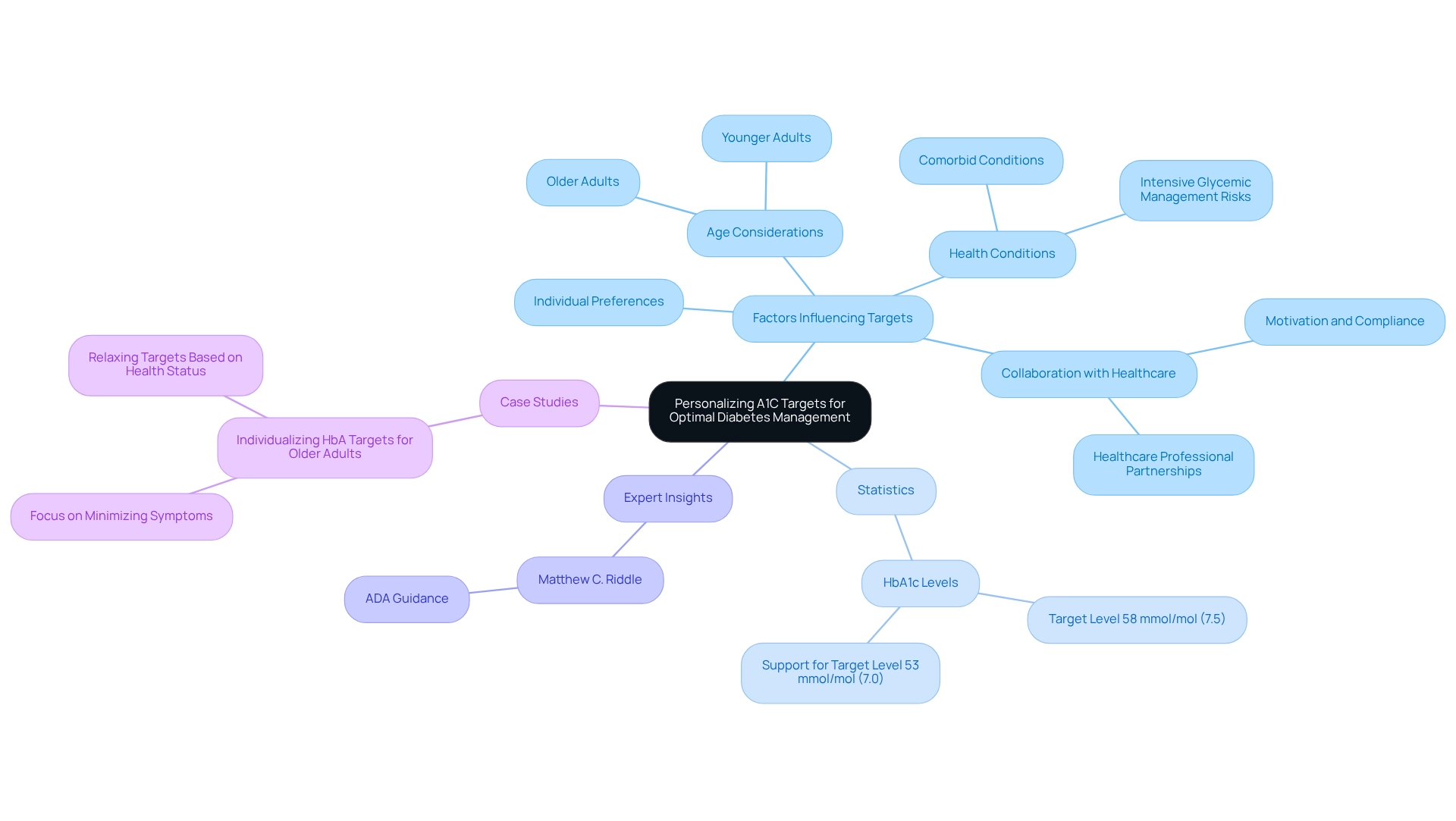
Strategies for Achieving and Maintaining Target A1C Levels
Achieving and maintaining A1C target levels is crucial for effective diabetes management, especially considering that 5,293 children and adolescents aged 10 to 19 years were diagnosed with type 2 diabetes. At T2DSolutions, we are here to assist you on this journey, offering resources and community support designed specifically for those recently diagnosed. Here are several strategies that can help:
-
Balanced Diet: Emphasizing a diet rich in whole grains, lean proteins, and a variety of fruits and vegetables is essential. Research indicates that dietary habits significantly influence A1C levels; for instance, individuals who consume a higher proportion of fiber-rich foods tend to achieve better glycemic control. T2DSolutions offers educational materials to help you make informed dietary choices.
-
Regular Physical Activity: Aim for at least 150 minutes of moderate exercise each week. Engaging in consistent physical activity not only helps lower A1C target levels but also enhances overall health. Studies show that the frequency of exercise is directly linked to improved blood sugar control, establishing it as an essential element of diabetes treatment. T2DSolutions can connect you with community exercise programs to keep you motivated.
-
Blood Glucose Monitoring: Regularly monitoring blood glucose levels is vital to gaining insights into how different foods, activities, and medications affect your blood sugar. This approach enables you to make educated choices regarding your diet and lifestyle, ultimately assisting in A1C control. As noted by M.G.C., the usage of the CGM (Continuous Glucose Monitoring) system serves as an educational tool for changing lifestyle and achieving better disease management. T2DSolutions provides guidance on effective monitoring techniques.
-
Medication Adherence: Taking medications as prescribed and maintaining open communication with healthcare providers regarding any challenges is essential. This collaboration is crucial for adjusting treatment plans to meet individual needs effectively. Addressing both FPG (Fasting Plasma Glucose) and PPG (Postprandial Glucose) is necessary for optimal therapeutic choices in patients not reaching glycemic targets. T2DSolutions can assist you in understanding your medication regimen better.
-
Stress Management: Implementing relaxation techniques such as yoga or meditation can be beneficial, as stress can adversely affect blood sugar levels. Managing stress is a frequently neglected element of glucose management that can lead to significant improvements in A1C target levels. T2DSolutions provides resources and community support to help you manage stress effectively. By integrating these strategies into your daily routine and utilizing the resources available through T2DSolutions, you can work towards achieving your A1C target levels, thereby enhancing your overall quality of life.
The increasing expenses linked to diabetes care, which amounted to approximately $413 billion in 2022, highlight the significance of efficient prevention and treatment approaches to lessen financial pressures on individuals and the healthcare system. Real-world examples demonstrate that individuals who embrace a comprehensive approach to diet and exercise frequently observe significant enhancements in their A1C readings, reinforcing the importance of a holistic management plan. Remember, you're not alone in this journey; we are here to support you every step of the way.
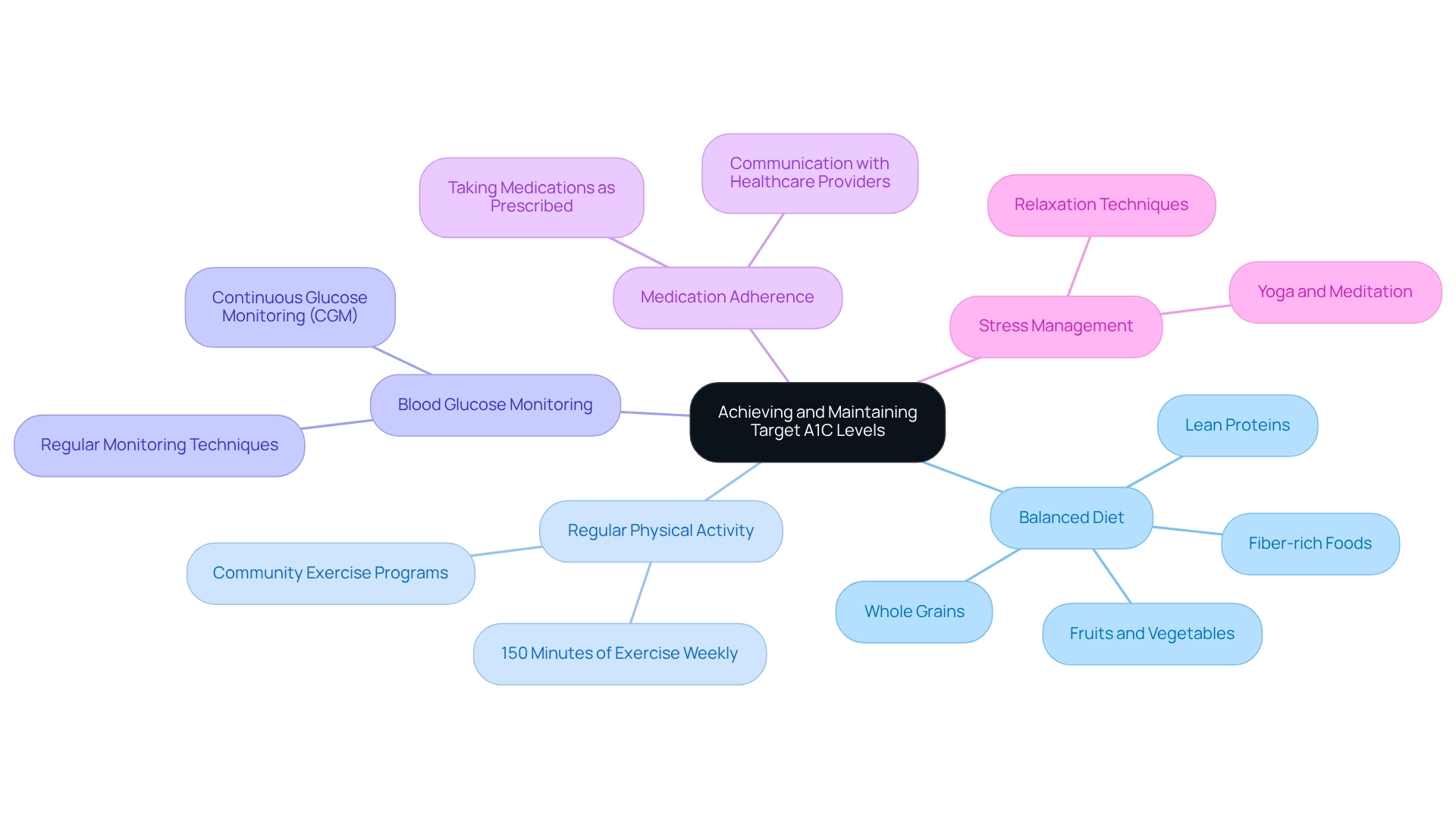
The Role of Healthcare Providers in A1C Management
Healthcare providers play a vital role in helping individuals manage their A1C target levels. They conduct regular tests to assess glycemic control and interpret results to tailor treatment plans effectively. By guiding individuals on essential lifestyle changes, medication adherence, and self-monitoring techniques, they empower patients to maintain their A1C target levels. Additionally, healthcare groups provide emotional support and resources, assisting individuals in navigating the challenges of their condition.
As T2DSolutions launches as a new resource hub for education on blood sugar management, it aims to support both healthcare providers and individuals in effectively managing A1C target levels. The importance of interprofessional collaboration is paramount; studies show that around 60% of individuals with blood sugar issues receive regular A1C tests from their healthcare providers. This highlights the necessity of consistent monitoring for effective management. Given the concerning statistic that in 2017-2018, there were 5,293 newly diagnosed cases of type 2 diabetes mellitus among children and adolescents aged 10 to 19 years, the role of healthcare providers in achieving A1C target levels becomes even more critical for our younger populations.
Successful collaborations between individuals and healthcare providers foster an atmosphere of trust and open dialogue, essential for achieving improved health outcomes. As Mohammed Ali observed, "Healthcare providers play a crucial role in supporting individuals through their diabetes journey," underscoring the significance of collaboration in diabetes care.
For instance, case studies have shown that healthcare teams actively involving individuals in their care plans see enhanced adherence to treatment and better control of A1C target levels. This collaborative approach not only improves the quality of care but also empowers patients to take an active role in their health journey. Furthermore, T2DSolutions will provide educational materials and community support programs to enhance assistance in health condition oversight.
The economic impact of diabetes is substantial; the total direct and indirect estimated costs of diagnosed cases in the United States reached $413 billion in 2022. This financial burden emphasizes the importance of investing in prevention and control programs to alleviate economic pressure on individuals and the healthcare system. As blood sugar management advances, the role of healthcare professionals remains crucial in ensuring that patients receive the comprehensive support they need to thrive.
Significantly, diabetes was the eighth leading cause of mortality in the United States in 2021, further highlighting the critical importance of managing this condition and the essential role of healthcare professionals in addressing this public health challenge.
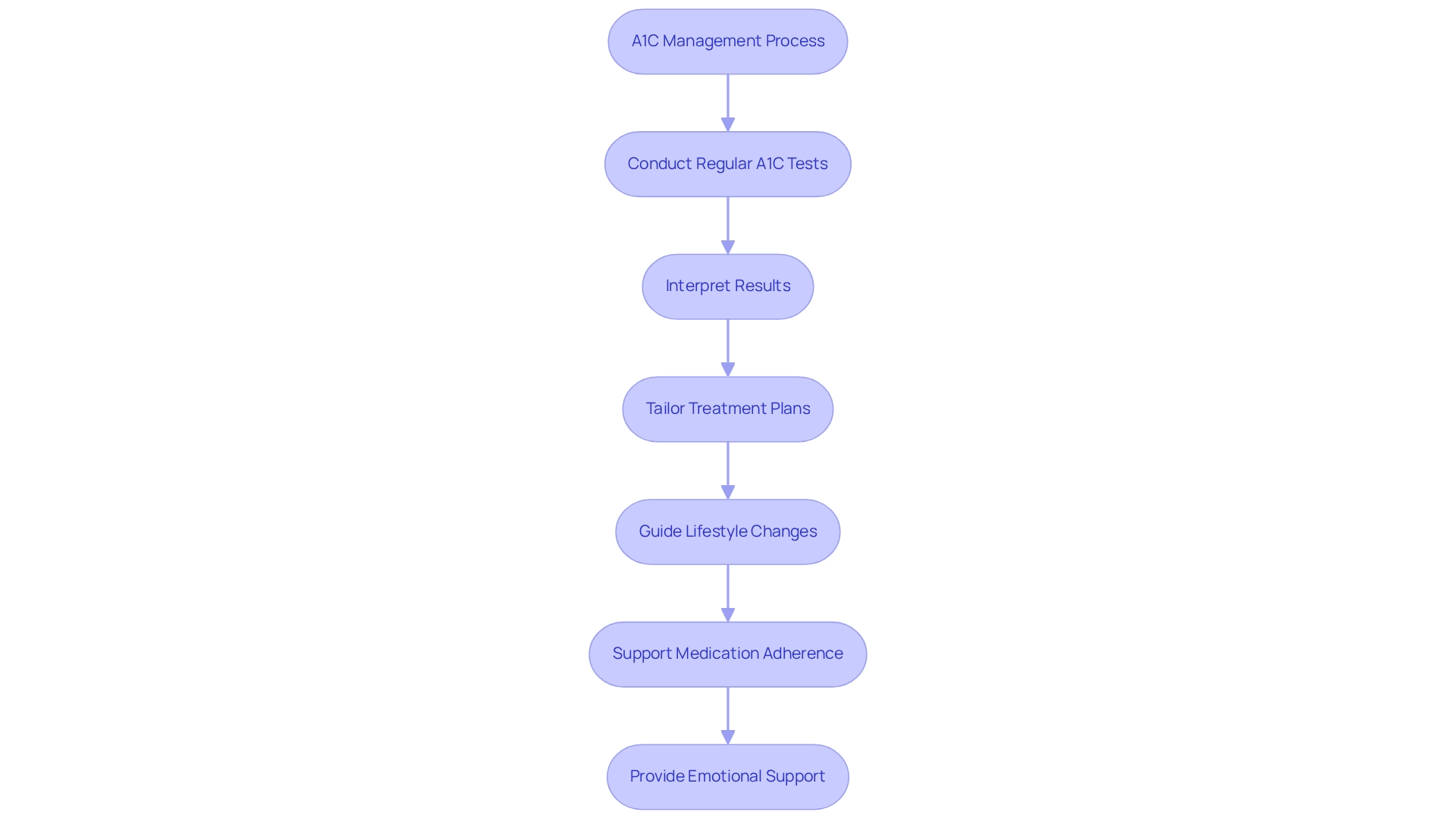
Emotional and Psychological Considerations in A1C Management
Navigating this condition often means traversing a complicated emotional landscape. Stress, anxiety, and depression can significantly hinder effective management. Research shows that these emotional states may lead to elevated A1C levels, making the path to optimal health more challenging. It’s crucial for individuals to prioritize their emotional well-being. Seeking help from mental health professionals, joining support groups, or practicing stress-reduction techniques like mindfulness and exercise can be incredibly beneficial.
The connection between emotional well-being and blood sugar control is underscored by findings that highlight the prevalence of anxiety and depression among those facing blood sugar challenges. Younger adults, women, and individuals with lower incomes are particularly vulnerable to these emotional hurdles, highlighting the need for targeted mental health support for these groups. A case study titled "Demographic Disparities in Depression Prevalence" reinforces these vulnerabilities and emphasizes the importance of focused interventions.
Moreover, evidence suggests that psychological support can lead to meaningful improvements in achieving A1C targets. Engaging in therapy or support groups not only alleviates diabetes-related distress but also fosters a sense of community and shared experience. While diabetes-related distress typically cannot be treated with medication, enhancing care through emotional support can be incredibly advantageous.
Additionally, the long-term costs associated with complications like renal failure and amputation further highlight the importance of effective management of both the condition and emotional health.
Roche's initiative to create a space for discussions on health-related mental wellness aims to combat stigma and promote early identification of issues, encouraging individuals to seek support from healthcare providers and their communities. Recognizing and addressing emotional factors is a vital aspect of effective diabetes care in 2025 and beyond. Remember, you’re not alone in this journey—we are here to support you every step of the way.
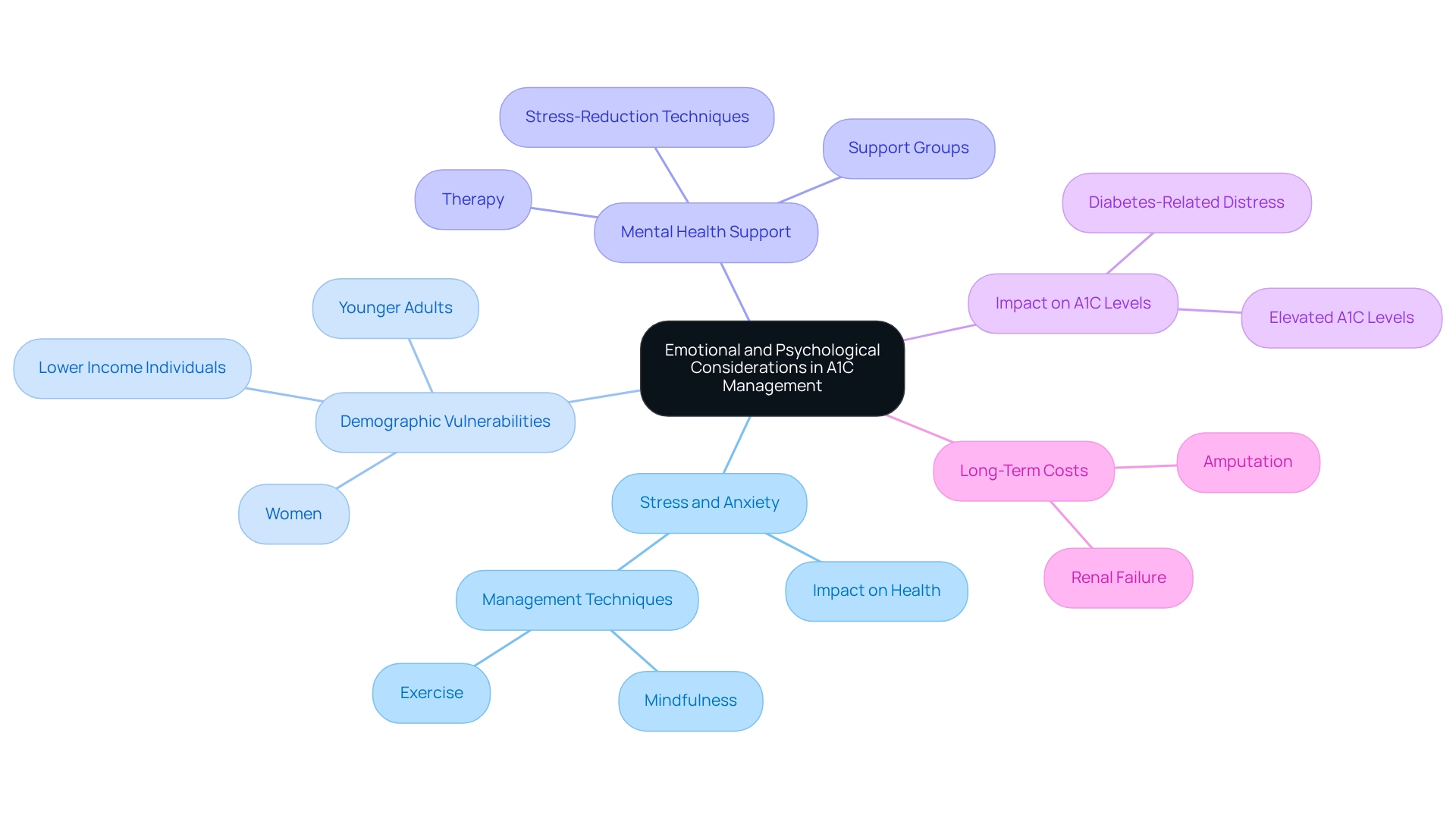
Conclusion
In summary, the A1C test is a vital cornerstone in diabetes management, offering essential insights into average blood sugar levels over time. Its significance goes beyond mere diagnosis; it plays a crucial role in customizing treatment plans and preventing complications associated with diabetes. As diabetes continues to rise globally, understanding A1C levels and their implications has become increasingly important for both patients and healthcare providers.
The journey toward effective diabetes management involves setting personalized A1C targets that consider individual health circumstances, age, and existing complications. Regular monitoring and proactive strategies—such as balanced diets, physical activity, and emotional support—are essential for maintaining optimal A1C levels. This comprehensive approach not only enhances the quality of life for those living with diabetes but also significantly reduces the risk of serious health complications.
Moreover, collaboration between patients and healthcare providers is key to successful diabetes management. By fostering open communication and a supportive environment, patients are empowered to take an active role in their care. As the landscape of diabetes care evolves, the commitment to education, personalized treatment, and emotional well-being will remain integral in navigating the complexities of this condition. Remember, you're not alone in this journey. With resources like T2DSolutions available, individuals can find the guidance and support necessary to thrive on their diabetes management journey.
Frequently Asked Questions
What is the A1C test?
The A1C test, or hemoglobin A1C, measures the average blood sugar levels over the past two to three months and indicates the proportion of hemoglobin molecules that have become glycated due to prolonged exposure to elevated glucose levels.
Why is regular A1C monitoring important?
Regular A1C monitoring is crucial for customizing treatment plans, preventing complications related to blood sugar disorders, and evaluating how well an individual is managing their A1C target levels.
What are the normal and abnormal A1C levels?
Normal A1C levels are below 5.7%. An A1C level between 5.7% and 6.4% suggests prediabetes, while a level of 6.5% or greater confirms a diagnosis of diabetes. The American Diabetes Association recommends A1C target levels of less than 7% for most adults managing blood sugar issues.
How do individual factors affect A1C target levels?
Individual A1C target levels can vary based on factors such as age, overall health, and specific medical conditions, which is why personalized care plans are essential.
What is the significance of A1C monitoring in managing diabetes?
A1C monitoring helps individuals achieve better control over their blood sugar, leading to fewer complications and improved overall health, reinforcing the collaborative effort needed in diabetes management.
Are there any limitations to the A1C test?
The A1C test is not suitable for diagnosing type 1 diabetes, gestational diabetes, or cystic fibrosis-related conditions, and it may yield inaccurate results under certain circumstances.
What are the emerging alternatives to the A1C test?
Emerging alternatives include estimated average glucose and glucose time in range, which utilize continuous glucose monitoring data for a more detailed perspective on blood sugar levels, but the A1C test remains a fundamental component of diabetes management.
What is the projected increase in diabetes cases in Europe by 2035?
The number of individuals affected by diabetes in Europe is forecasted to increase from 52 million to 69 million by 2035.
What role do healthcare professionals play in A1C management?
Healthcare professionals work in an interprofessional team environment to enhance individual results in managing blood sugar disorders, emphasizing the importance of collaboration in patient care.
How can newly diagnosed individuals get support for diabetes management?
Organizations like T2DSolutions offer resources and assistance to empower newly diagnosed individuals for effective condition oversight and management.
